Affordable Diamonds: Your Comprehensive Buying Guide
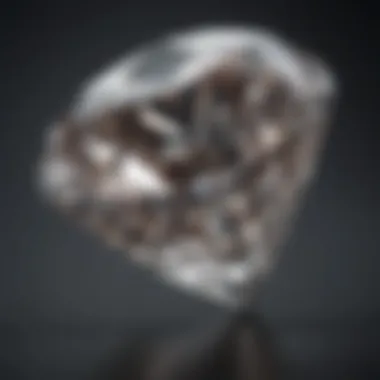

Intro
The pursuit of affordable diamonds has gained momentum in today’s market. Many individuals seek to understand how to obtain quality diamonds without overspending. This guide aims to illuminate the intricacies of diamond pricing, offering insights into the factors that dictate costs and the alternatives that exist.
Understanding the terminology and the quality markers is essential.
The Four Cs—carat, cut, clarity, and color—play a pivotal role in determining a diamond's value. Furthermore, lab-grown diamonds present a significant breakthrough in the gemstone market, offering a more budget-friendly alternative without sacrificing beauty. This article will navigate you through the landscape of affordable diamonds, equipping you with the knowledge needed to make informed purchasing decisions.
Gemstone Overview
Definition and characteristics
Diamonds, traditionally regarded as the ultimate symbol of luxury and commitment, are actually formed from carbon under extreme heat and pressure deep within the Earth. Their characteristics set them apart, primarily their hardness, which is unparalleled in natural gemstones. This exceptional durability makes diamonds desirable not only for jewelry but also for industrial applications.
Classification of gemstones
Diamonds fall under the category of gemstones, which can be classified based on their formation and characteristics. Gemstones are typically categorized as precious or semi-precious. Diamonds are always viewed as precious gemstones due to their rarity and strength. Other gemstones, such as sapphires and rubies, also carry a significant value, but diamonds often dominate the market.
"Understanding the classification of gemstones helps consumers navigate through their options more effectively, especially when seeking affordable alternatives."
Properties of Gemstones
Physical properties
The physical properties of diamonds include their hardness, brilliance, and clarity. The Mohs hardness scale places diamonds at a perfect ten, which means they do not scratch easily. Their brilliance is a result of their ability to reflect and refract light, giving them the iconic sparkle. Clarity refers to the presence of internal or external flaws, which can affect the stone's appearance and, subsequently, its price.
Chemical properties
From a chemical standpoint, diamonds are composed of carbon atoms arranged in a crystal structure known as the diamond cubic lattice. This unique formation contributes to their physical properties, making them both strong and aesthetically appealing. Understanding these chemical properties can assist you in appreciating the value and quality of the diamonds you consider.
By comprehending the basics of gemstones, including diamonds, you position yourself advantageously in the diamond market. This knowledge enhances your ability to identify what truly constitutes value in an affordable diamond without compromising on quality. As this guide continues, it will delve deeper into pricing factors and the impact of quality markers on affordability.
Intro to Affordable Diamonds
Diamonds have symbolized luxury and status for centuries. However, the idea of owning a diamond is often clouded by thoughts of high expenses. This article examines the concept of affordable diamonds. Understanding affordable diamonds is crucial for consumers who wish to acquire these precious stones without compromising their financial well-being.
Understanding the Diamond Market
To grasp what affordable diamonds entail, one must delve into the diamond market itself. The diamond industry, while traditional and steeped in history, operates on various complexities. These include supply chains that stretch across continents, ethical sourcing challenges, and fluctuating market demands. Moreover, global events can lead to changes in availability and pricing of diamonds.
The diamond market is diverse, with natural diamonds coexisting alongside lab-grown options. Both types appeal to different consumer segments. Natural diamonds tend to be seen as more valuable due to their rarity, while lab-grown diamonds offer an accessible alternative that often comes at a lower price. This understanding allows buyers to make informed decisions when seeking affordable options in the marketplace.
Defining Affordability in Diamonds
Affordability in the context of diamonds can be subjective. What is affordable for one person might be out of reach for another. In general, affordability refers to options that provide value without excessive spending. Thus, it is necessary to look at the total cost involved, which may include the price of the diamond itself, setting, and insurance.
Various factors help define what makes a diamond affordable:
- Budget Constraints: Individuals have different financial limitations that directly influence their purchasing power.
- Market Variability: Diamond prices fluctuate based on trends, availability, and consumer demand. This variability can lead to opportunities for buyers to find gems at lower prices during off-peak seasons.
- Alternative Choices: Understanding options like lab-grown diamonds, used diamonds, or fancy color diamonds can widen the affordability spectrum.
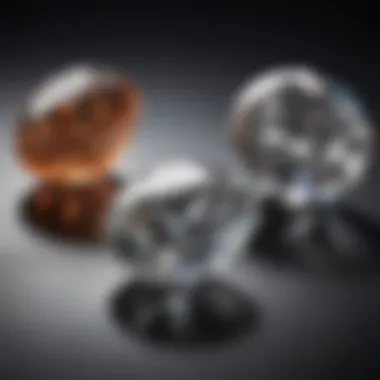
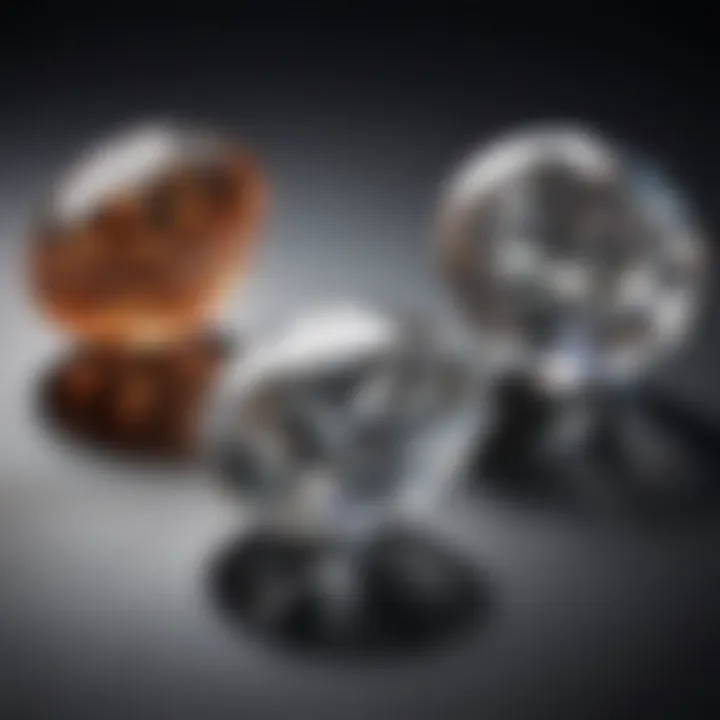
The Four Cs of Diamonds
The Four Cs are crucial in understanding diamond quality and value, particularly when seeking affordable options. The elements—carat weight, cut quality, clarity grades, and color tones—define the diamond's overall appearance and price point. For those aiming to balance budget constraints with quality, knowledge of these factors can lead to more informed purchasing decisions.
Carat Weight
Carat weight measures a diamond's size and weight. One carat equals 200 milligrams. This metric significantly influences the diamond's price. Larger diamonds tend to be more expensive not only because of the material value but also due to their rarity. For example, a 1-carat diamond costs more per carat than a 2-carat diamond.
When considering affordability, opting for a diamond just below a full carat mark can yield substantial savings. A 0.90-carat diamond may look visually similar to a 1-carat stone but often costs much less. Buyers can strategically focus on smaller carat weights that maintain aesthetic appeal while being budget-friendly.
Cut Quality
The cut quality of a diamond refers to how well it has been shaped and polished. This aspect affects its brilliance and sparkle. It is essential to note that the cut is not merely about the diamond's shape, like round or princess, but its proportions, symmetry, and finish as well.
A well-cut diamond will reflect light better, creating stunning visual effects. Unlike carat weight, which tends to increase price with size, a high-cut quality can significantly elevate the price. To maximize budget, consider stones with good or very good cut grades. Lower cut grades may save costs but can adversely impact the diamond's overall appearance.
Clarity Grades
Clarity refers to the presence of internal or external flaws, also known as inclusions and blemishes. The Gemological Institute of America (GIA) provides clarity grading, ranging from Flawless (no inclusions visible under 10x magnification) to Included (inclusions visible to the naked eye).
For affordable options, look for diamonds with clarity grades of VS2 (Very Slightly Included) or SI1 (Slightly Included). These stones may have some minor imperfections but typically appear eye-clean to most viewers. This allows for significant cost savings while still providing beauty and quality.
Color Tones
The color of a diamond impacts its desirability and pricing. Color grades range from D (colorless) to Z (light yellow or brown). Generally, the more colorless a diamond is, the more valuable it is. However, many buyers might find diamonds in the G-H range, which appear colorless to the naked eye but are less expensive.
Choosing stones with slight color can be a cost-effective way to acquire a larger, visually appealing diamond without straining your budget. Alternatives like fancy color diamonds, which display unique brilliance, also provide varied market opportunities.
A well-rounded understanding of the Four Cs helps buyers smartly navigate the diamond market, leading to quality purchases that align with budgetary needs.
Incorporating the knowledge of the Four Cs into purchasing decisions allows customers to find a balance between appearance and cost, ensuring that their investment offers both satisfaction and value.
Market Pricing Factors
Understanding the market pricing factors associated with diamonds is crucial when searching for affordable options. The cost of diamonds is influenced by a variety of elements, including supply and demand dynamics, retail markup variations, and cultural considerations. Evaluating these factors can help buyers make informed decisions and ultimately secure the best possible value.
Supply and Demand Dynamics
The basic economic principle of supply and demand plays a significant role in the diamond market. When the demand for diamonds exceeds the available supply, prices tend to rise. Conversely, when there are more diamonds on the market than buyers, prices decline. This fluctuation can be influenced by seasonal trends, economic conditions, and consumer preferences.
Factors such as mining output and market saturation affect supply. For instance, natural diamond mining is limited and can be affected by geopolitical issues or environmental concerns. In contrast, lab-grown diamonds are produced in more controlled environments, which allows for a more stable supply. Understanding these dynamics can help buyers anticipate price changes and identify optimal purchasing times.
Retail Markup Variations
Retail markup is the difference between the wholesale price of a diamond and its retail selling price. Different retailers apply different markup strategies, which can significantly influence the final price that consumers pay. Factors affecting retail markup can include the retailer's location, marketing costs, and target demographics.
Some jewelers are known for higher markups due to their brand reputation or exclusivity, while others offer more competitive pricing to attract cost-conscious customers. Online retailers often have lower operational costs than brick-and-mortar stores, resulting in more favorable pricing. Thus, researching various retailers and comparing prices can unearth more affordable options.
Cultural Influences on Pricing
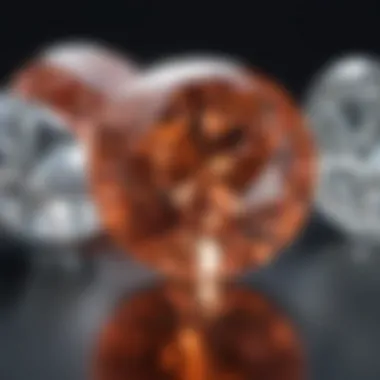
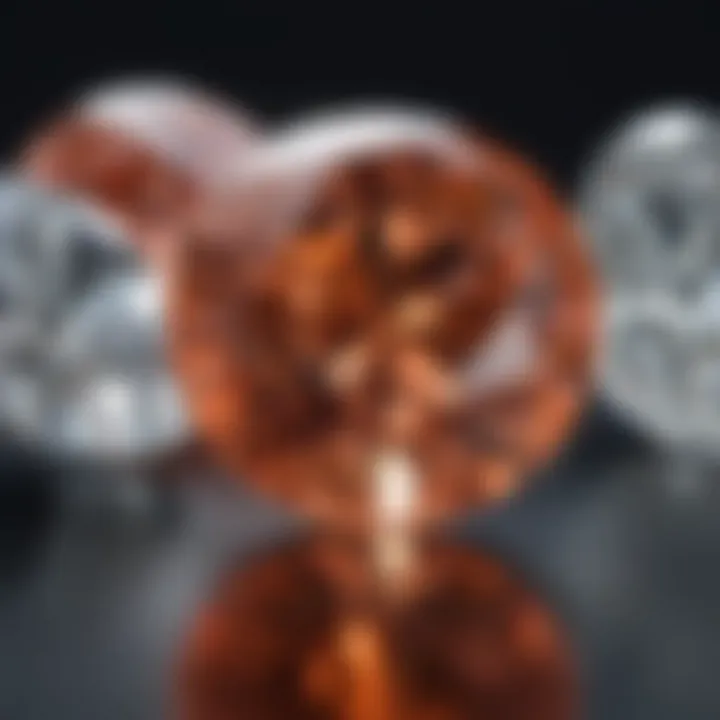
Cultural factors can significantly shape perceptions of value and pricing in the diamond market. In some cultures, diamonds symbolize status and prestige, leading to a higher demand and subsequently inflated prices. For example, cultural ceremonies that emphasize diamond gifting can create spikes in demand, especially during specific times of the year, such as wedding season.
Additionally, marketing campaigns often target cultural beliefs, positioning diamonds as essential gifts for celebrations and milestones. These cultural narratives can shift consumer perspectives about what constitutes value, thereby influencing purchasing decisions. By being aware of these trends, buyers can navigate the market more strategically, aligning their purchases with personal values and budget considerations.
Understanding the market dynamics, from supply and demand to cultural influences, is essential for anyone looking to buy affordable diamonds.
Types of Affordable Diamonds
Understanding the different types of affordable diamonds is crucial for buyers who want to maximize value without sacrificing quality. Each category has unique characteristics that can influence both the price and the appeal of the diamond. These distinctions help consumers make informed choices that fit their budgets and aesthetic preferences.
Natural vs. Lab-Grown Diamonds
Natural diamonds are formed over millions of years deep within the Earth’s mantle under intense heat and pressure. They are mined from the earth, which can be an extensive and costly process. The rarity and long history of natural diamonds contribute to their high price. However, they have a certain allure that many buyers find hard to resist.
On the other hand, lab-grown diamonds, or synthetic diamonds, are created in controlled environments using advanced technology. They possess the same physical, chemical, and optical properties as natural diamonds and can often be produced at a significantly lower cost. Many consider them an ethical choice; they do not involve mining, which can harm the environment and communities.
When considering affordability, lab-grown diamonds often offer an attractive option. They typically cost 20-40% less than their natural counterparts, providing buyers with larger carat sizes or higher quality at a similar price point.
Ultimately, the choice between natural and lab-grown diamonds depends on personal values and preferences.
Fancy Color Diamonds
Fancy color diamonds distinguish themselves by their vibrant hues, ranging from yellow and pink to blue and green. These hues intensify the diamond's overall appeal and can significantly impact its price. In contrast to traditional colorless diamonds, affordable fancy color diamonds can offer remarkable beauty and uniqueness at relatively lower prices.
For example, light yellow diamonds may be more affordable than white diamonds, while deeper shades, like vivid pinks or blues, can command sky-high prices.
One important aspect of fancy color diamonds is their grading system, which evaluates the hue, tone, and saturation of the color. Buyers should educate themselves on these factors to understand what influences value.
Choosing a fancy color diamond allows individuals to own a piece of jewelry that is not only stunning but also unique. These diamonds can serve as statement pieces that stand out when compared to classic designs.
Used and Vintage Diamonds
Used and vintage diamonds offer a compelling option for budget-conscious buyers. They come with a history that adds to their charm, often featuring unique settings and designs that may not be widely available today. Vintage diamonds typically refer to stones that were cut before the 1950s. They often hold a unique character and may have specialized cuts that enhance their visual appeal.
Buying used diamonds can lead to significant savings. Usually, the retail price reflects the initial cost rather than any modern appreciation of value.
Moreover, choosing a used diamond implies a sustainable approach to purchasing, as it means giving a new life to an existing piece rather than contributing to new diamond mining.
Where to Buy Affordable Diamonds
Understanding the diamond market is vital for any potential buyer, especially when searching for affordable options. The avenues for purchasing diamonds are diverse, and each comes with its own set of advantages and considerations. Knowing where to look can make the difference between a good deal and a less than ideal purchase.
Online Retail Platforms
The rise of online shopping has transformed how consumers purchase diamonds. Websites like James Allen, Blue Nile, and Brilliant Earth specialize in offering extensive selections of affordable diamonds. These platforms provide detailed filters for narrowing down options based on the Four Cs. Buyers can often find competitive prices due to lower overhead costs compared to traditional storefronts.
Shopping online also offers customer reviews and comprehensive educational resources about diamonds. Many reputable online retailers provide certified diamonds, ensuring a level of quality assurance. Additionally, promotions and discounts can be found seasonally, which further enhances affordability. However, buyers must be diligent regarding return policies and ensure secure payment options are offered.
- Pros of online purchasing:
- Cons to consider:
- Wider selection of affordable options.
- Competitive pricing.
- Ability to compare multiple options easily.
- Inability to physically inspect the diamond until delivery.
- Potential for discrepancies in color or clarity upon arrival.
Local Jewelers and Markets
Local jewelers present a more personalized shopping experience. They often have specific knowledge about diamonds, and many are willing to negotiate prices. Buying from an established local jeweler can allow buyers to inspect the diamond in person, giving confidence in their selections. Additionally, local jewelers may have unique pieces that are not available online.
Visiting local markets or gem fairs can yield unexpected finds. These venues can be excellent for discovering unique diamond shapes or sizes, often at lower prices than those listed in standard retail outlets. However, it is essential to research the jeweler's reputation and seek out certifications to ensure the quality of the diamonds.
- Advantages of shopping locally:
- Drawbacks may include:
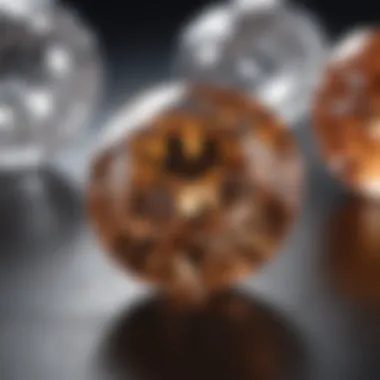
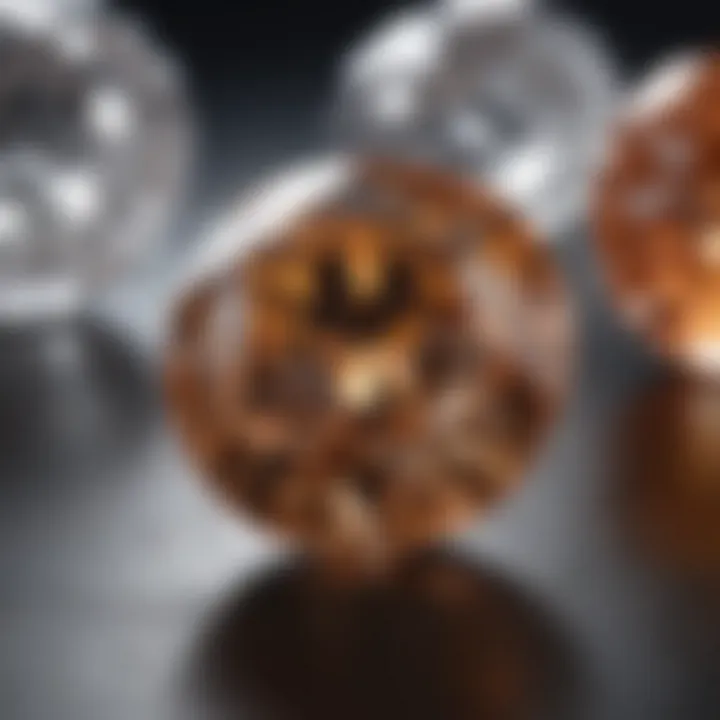
- Personalized service and expertise.
- Opportunity to examine the diamond physically.
- Limited selection compared to online options.
- Possible higher pricing due to overhead costs.
Auction Houses
For those seeking distinct or unique diamonds, auction houses can be a fascinating option. Auctions typically feature a range of diamonds at varying price points, from affordable to extremely expensive. Buyers can often find vintage or rare pieces that may not be available otherwise.
While this avenue can lead to remarkable deals, it requires a keen understanding of the diamond market and auction strategies. Buyers should be prepared to act quickly and stay within their budget, as bidding can be competitive. It is crucial to research the auction house's reputation and understand their fees and processes.
"While auction houses can offer unique finds, the buyer must approach with knowledge and preparation. Prior inspection of lots is usually allowed, providing a chance to assess quality."
- Pros of auction purchasing include:
- Cons might be:
- Access to unique or rare diamonds.
- Possibility of finding lower-than-retail prices.
- Competitive bidding environment.
- Risk of overspending due to excitement.
By exploring these various purchasing routes—online platforms, local jewelers, and auctions—buyers can navigate the diamond purchasing landscape more effectively. Knowing where to buy affordable diamonds can ultimately help in finding the right stone that meets both budgetary and quality needs.
Assessing Quality and Value
When navigating the world of affordable diamonds, understanding quality and value stands as a critical element. The intricate nature of the diamond market means that prices can fluctuate significantly based on several factors, particularly the characteristics identified by the Four Cs: carat, cut, clarity, and color. By assessing these aspects, buyers can make informed decisions that align their budget with quality expectations. It is crucial to be aware of both certifications available and subtle nuances between similar diamonds, as this knowledge can lead to substantial savings without sacrificing quality.
Certification and Grading
Certification and grading of diamonds play an essential role in establishing their authenticity and quality. Third-party gemological laboratories, such as the Gemological Institute of America (GIA) or the International Gemological Institute (IGI), offer detailed grading reports that the diamond's features and characteristics. These reports include detailed descriptions of the Four Cs, enabling consumers to compare diamonds effectively.
When looking for affordable options, it is imperative to look for diamonds that come with a reliable certification. A well-certified diamond ensures peace of mind, as it reduces the risk of overpaying for a lower-quality stone. Additionally, knowing how each C influences overall value can help buyers prioritize which attributes to focus on, often leading to discovering under-appreciated gems at lower prices.
"A certification is not just a piece of paper; it's an assurance of quality that can help navigate the complex diamond market."
Comparing Similars
In the quest for affordable diamonds, comparing similar stones becomes necessary. Here, various factors can aid in discerning which diamond offers the best value for its cost. To do this effectively, one must consider not only the Four Cs but also additional factors like shape, brand reputation, and market trends. For instance, a diamond with a slightly lower carat weight could appear more impressive due to its superior cut quality.
To aid in the comparison process, creating a brief checklist can prove helpful:
- Quality Metrics: Assess the rating of the Four Cs for each diamond.
- Price Comparison: Evaluate how similar qualities vary in price across vendors.
- Historical Trends: Check current pricing guides to understand market fluctuations.
By honing the skills of comparison, buyers can better identify diamonds that align with both their preferences and budgets, ultimately leading to informed purchasing decisions.
Ultimately, mastering the art of assessing quality and value ensures that buyers not only get a fair deal but also make a selection that meets their emotional and financial expectations.
Culmination
In this article, we explored the nuances surrounding affordable diamonds. Understanding the landscape of diamond pricing is crucial for any buyer aiming to make informed decisions. The conclusion serves as a culmination of the insights gathered throughout this guide.
When considering affordable diamonds, it is important to weigh several elements carefully. First, the Four Cs – carat, cut, clarity, color – undeniably influence a diamond's price. Recognizing how each of these characteristics contributes to overall quality helps buyers prioritize their preferences. This understanding allows for more targeted selections without straying too far from budget constraints.
Another notable aspect is the distinction between natural and lab-grown diamonds. Lab-grown options often provide superior value for the price, presenting a compelling alternative for those who wish to maximize their investment. Additionally, one should also consider vintage or second-hand diamonds, which can offer remarkable beauty at reduced prices.
As we synthesized various purchasing strategies and tips, it became clear that knowing where to buy is also critical. Online platforms, local jewelers, and auction houses all provide unique advantages and challenges. Each route carries potential for finding excellent deals while maintaining quality standards.
Ultimately, this guide aims to empower gemstone enthusiasts, collectors, jewelry designers, and geology lovers alike with the knowledge required for smart shopping in the diamond market. By navigating this complex landscape effectively, buyers can find affordable options that resonate with their personal taste and financial realities.
"Knowledge empowers us to make the right choices in the diamond market. It's not always about luxury, but finding what truly reflects our values."
Thus, as you venture into the world of affordable diamonds, keep your goals in sight. Whether it is for personal use or as an investment, the journey should reflect your unique story.



